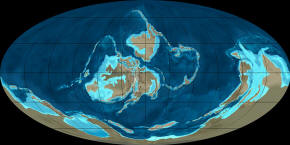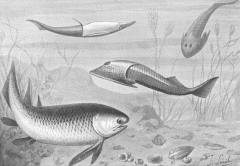Silurian Paleogeography
 |
During the Silurian, Gondwana continued a slow southward drift to high southern latitudes, but there is evidence that the Silurian icecaps were less extensive than those of the late Ordovician glaciation.The southern continents remained united during this period.The melting of icecaps and glaciers contributed to a rise in sea level, recognizable from the fact that Silurian sediments overlie eroded Ordovician sediments, forming an unconformity. Other cratons and continent fragments drifted together near the equator, starting the formation of a second supercontinent known as Euramerica.
When the proto-Europe collided with North America, the collision folded coastal sediments that had been accumulating since the Cambrian off the east coast of North America and the west coast of Europe. This event is the Caledonian orogeny, a spate of mountain building that stretched from New York State through conjoined Europe and Greenland to Norway. At the end of the Silurian, sea levels dropped again, leaving telltale basins of evaporites in a basin extending from Michigan to West Virginia, and the new mountain ranges were rapidly eroded. The Teays River, flowing into the shallow mid-continental sea, eroded Ordovician strata, leaving traces in the Silurian strata of northern Ohio and Indiana.
The vast ocean of Panthalassa covered most of the northern hemisphere. Other minor oceans include two phases of the Tethys— the Proto-Tethys and Paleo-Tethys— the Rheic Ocean, a seaway of the Iapetus Ocean (now in between Avalonia and Laurentia), and the newly formed Ural Ocean.
Climate
|
Did You Know? |
During this period, the Earth entered a long warm greenhouse phase, and warm shallow seas covered much of the equatorial land masses. Early in the Silurian, glaciers retreated back into the South Pole until they almost disappeared in the middle of Silurian. The period witnessed a relative stabilization of the Earth's general climate, ending the previous pattern of erratic climatic fluctuations. Layers of broken shells (called coquina) provide strong evidence of a climate dominated by violent storms generated then as now by warm sea surfaces. Later in the Silurian, the climate cooled slightly, but in the Silurian-Devonian boundary, the climate became warmer.
Marine Biota
 |
| Artist's Impression of Silurian Fish |
Coral reefs made their first appearance during this time, built by extinct tabulate and rugose corals. The first bony fish, the Osteichthyes, appeared, represented by the Acanthodians covered with bony scales; fishes reached considerable diversity and developed movable jaws, adapted from the supports of the front two or three gill arches. A diverse fauna of Eurypterids (Sea Scorpions) -- some of them several meters in length—prowled the shallow Silurian seas of North America; many of their fossils have been found in New York State. Leeches also made their appearance during the Silurian Period. Brachiopods, bryozoa, molluscs, hederelloids and trilobites were abundant and diverse.
Terrestrial Biota
The Silurian was the first period to see macrofossils of extensive terrestrial biota, in the form of moss forests along lakes and streams.
The first fossil records of vascular plants, that is, land plants with tissues that carry food, appeared in the second half of the Silurian period. The earliest known representatives of this group are the Cooksonia (mostly from the northern hemisphere) and Baragwanathia (from Australia). A primitive Silurian land plant with xylem and phloem but no differentiation in root, stem or leaf, was much-branched Psilophyton, reproducing by spores and breathing through stomata on every surface, and probably photosynthesizing in every tissue exposed to light. Rhyniophyta and primitive lycopods were other land plants that first appear during this period. Neither mosses nor the earliest vascular plants had deep roots. Silurian rocks often have a brownish tints, possibly a result of extensive erosion of the early soils.
Some evidence suggests the presence of predatory trigonotarbid arachnoids and myriapods in Late Silurian facies. Predatory invertebrates would indicate that simple food webs were in place that included non-predatory prey animals. Extrapolating back from Early Devonian biota, Andrew Jeram et al. in 1990 suggested a food web based on as yet undiscovered detritivores and grazers on microorganisms.
End Extinction Event
At the end of Silurian, a series of minor extinction events, including the Lau event, occurred. They were probably caused by climate change or impact events.
The Lau event was the last of three relatively minor mass extinctions during the Silurian period, having a major effect on the conodont fauna (but barely scathing the graptolites). It coincided with a global low point in sea level, is closely followed by an excursion in geochemical isotopes in the ensuing late Ludfordian faunal stage and a change in depositional regime.
Biotic Impact
The Lau event started at the beginning of the late Ludfordian, a subdivision of the Ludlow stage, about 420 million years ago. Its strata are best exposed in Gotland, Sweden, taking its name from the parish of Lau. Its base is set at the first extinction datum, in the Eke beds, and despite a paucity of data, it is apparent that most major groups suffered an increase in extinction rate during the event; major biotal changes are observed worldwide at correlated rocks, with a "crisis" observed in populations of conodonts and graptolites. More precisely, conodonts suffered in the Lau event, and graptolites in the subsequent isotopic excursion. Local extinctions may have played a role in many places, especially the increasingly enclosed Welsh basin; the event's relatively high severity rating of 6.2 does not bely the fact that many taxa became re-established shortly after the event, presumably surviving in refugia or in environments that have not been preserved in the geological record. Despite taxa persisting, community structure was permanently altered by the event, with many taxa failing to regain the niches lost in the event.
Isotopic Effects
A peak in δ13C, accompanied by fluctuations in other isotope concentrations, is often associated with mass extinctions. Some workers have attempted to explain this event in terms of climate or sea level change — perhaps arising due to a build-up of glaciers; however, such factors alone do not appear to be sufficient to explain the events. An alternative hypothesis is that changes in ocean mixing were responsible. An increase in density is required to make water downwell; the cause of this densification may have changed from hypersalinity (due to ice formation and evaporation) to temperature (due to water cooling).
However, the δ13C curve slightly lags conodont extinctions - hence the two events may not represent the same thing. Hence the term 'Lau event' is used solely for the extinction, not the following isotopic activity, which is named after the time period in which it occurs.
Loydell suggests many causes of the isotopic excursion, including increased carbon burial, increased carbonate weathering, changes in atmospheric and oceanic interactions, changes in primary production, and changes in humidity or aridity. He uses a correlation between the events and glacially-induced global sea level change to suggest that carbonate weathering is the major player, with other factors playing a less significant role.
Sedimentalogical Impacts
Profound sedimentary changes occurred at the beginning of the Lau event; these are probably associated with the onset of sea level rise, which continued through the event, reaching a high point at the time of deposition of the Burgsvik beds, after the event.
These changes appear to display anachronism, marked by an increase in erosional surfaces and the return of flat-pebbled conglomerates in the Eke beds. This is further evidence of a major blow to ecosystems of the time — such deposits can only form in conditions similar to those of the early Cambrian period, when life as we know it was only just becoming established. Indeed, stromatolites, which rarely form in the presence of abundant higher life forms, are observed during the Lau event and, occasionally, in the overlying Burgsvik beds; microbial colonies of Rothpletzella and Wetheredella become abundant. This suite of characteristics is common to the larger end-Ordovician and end-Permian extinctions.
Return to the Old Earth Ministries Online Earth History Curriculum homepage.
![]()
1 Length of the Year during the Silurian and Devonian Periods: New Values, by S. J. Mazzullo, GSA Bulletin; April 1971; v. 82; no. 4; p. 1085-1086.
Source: Silurian